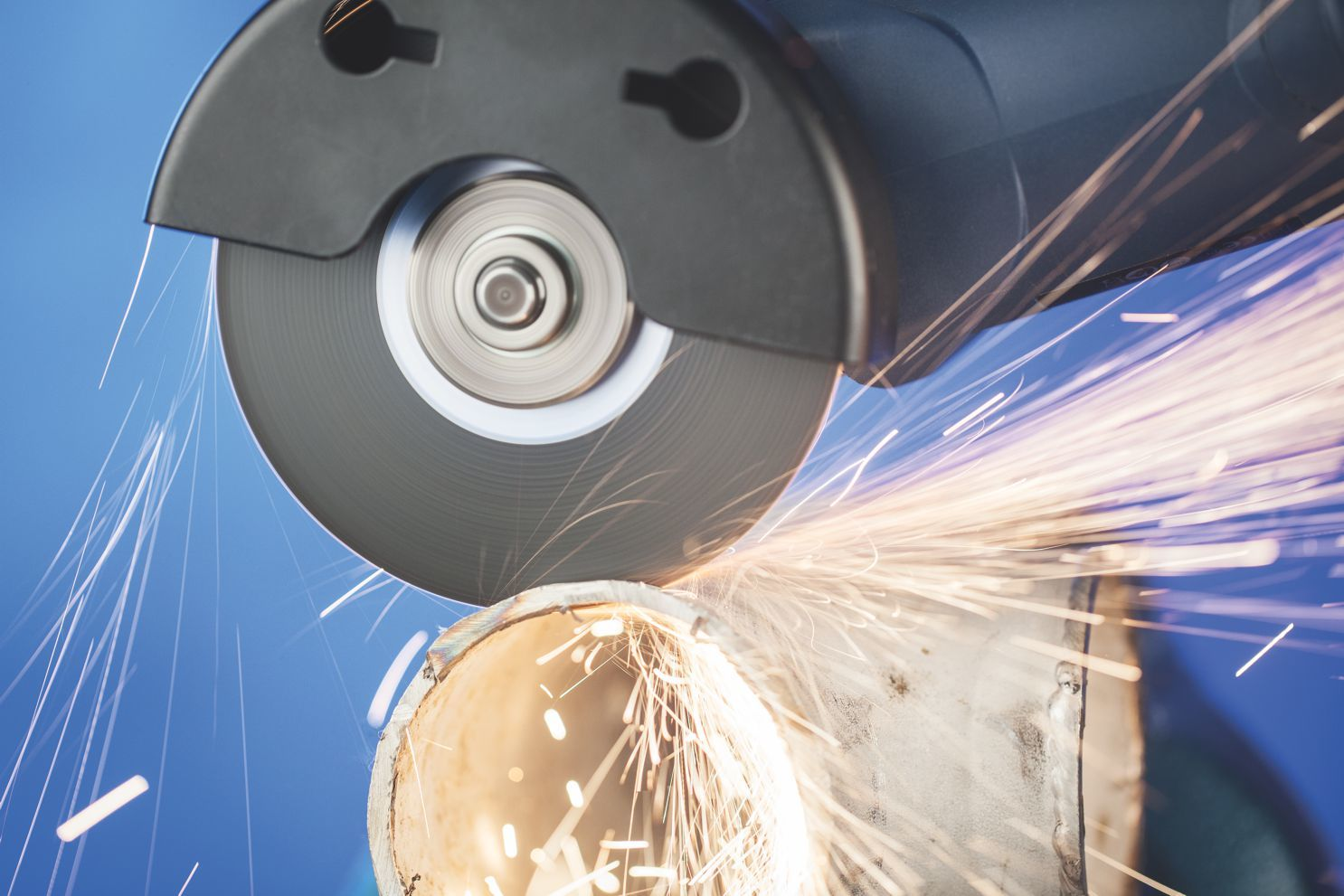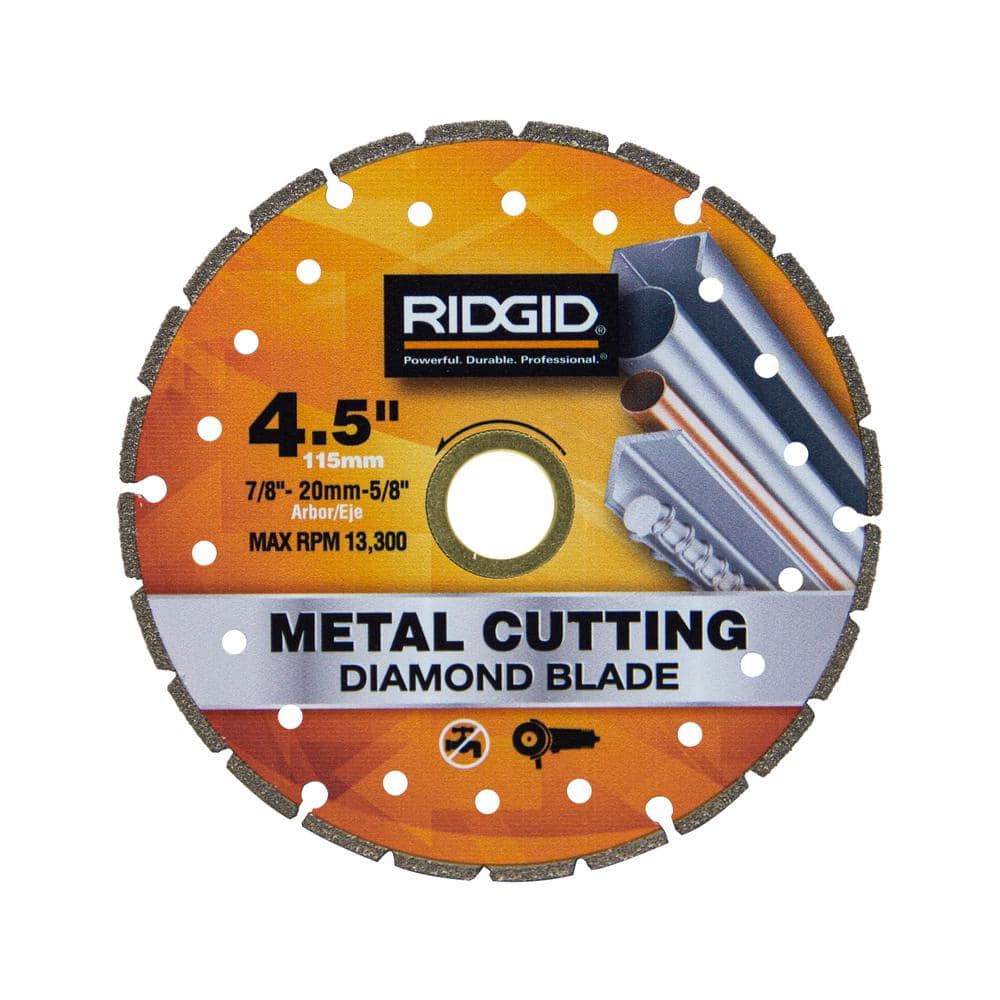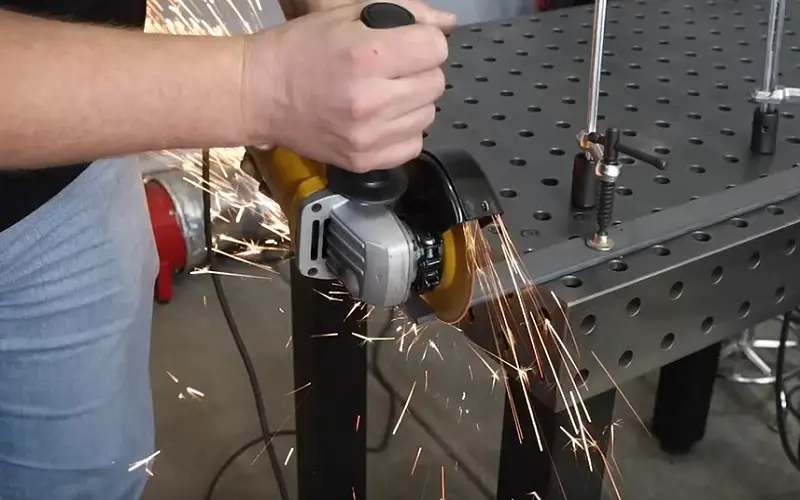For cutting metal with an angle grinder, use a metal cutting blade. When working with an angle grinder for cutting metal, selecting the right blade is crucial.
Metal cutting blades are specifically designed for cutting through metal efficiently and effectively. These blades typically have a specific tooth configuration and material composition optimized for cutting through metal with precision.
By choosing the appropriate metal cutting blade for your angle grinder, you can ensure clean and accurate cuts while maximizing the tool’s performance and durability.
Selecting the right blade for cutting metal will not only enhance your cutting experience but also improve safety by reducing the likelihood of kickback or other potential hazards during operation.
Contents
Angle Grinder Basics
Before we dive into the nitty-gritty of choosing the right blade to cut metal with an angle grinder, let’s first cover the basics of this powerful tool.
An angle grinder, also known as a side grinder or disc grinder, is a versatile handheld power tool extensively used in various industries and DIY projects.
It consists of a motor-driven spinning disc that enables the user to cut, grind, polish, and shape different materials with precision and speed.
What Is An Angle Grinder?
An angle grinder is a handheld power tool that features a right-angle gearhead, hence the name “angle” grinder.
It is primarily designed for cutting, grinding, polishing, and polishing different materials like metal, stone, concrete, tiles, and more.
With its compact size and powerful motor, an angle grinder is widely used in construction, metalworking, fabrication, and other industries.
How Does An Angle Grinder Work?
Understanding how an angle grinder works is essential before proceeding with any metal-cutting task. The tool operates through a combination of rotary motion and abrasive action.
The motor turns a spinning disc at high speeds, typically ranging from 5,000 to 10,000 revolutions per minute (RPM). This disc, also known as a cutting or grinding wheel, is mounted on the gearhead, which transfers the power from the motor to the disc.
The cutting wheel of an angle grinder is made up of a composite material embedded with abrasive particles, such as diamonds or aluminum oxide.
As the disc rotates, these abrasive particles remove material from the workpiece, enabling precise cutting or grinding. The operator applies slight pressure on the angle grinder’s handle, guiding the spinning disk along the desired cutting path.
In addition to the cutting or grinding wheels, an angle grinder can also be equipped with various attachments and accessories, allowing it to perform other tasks.
These include wire brushes for cleaning and rust removal, sanding discs for surface preparation, and polishing pads for buffing and finishing.
In conclusion, understanding the basics of an angle grinder, including its purpose and working mechanism, is crucial for anyone who wishes to use this versatile tool effectively.
Knowing how an angle grinder operates and what it is capable of will help in selecting the right blade for cutting metal, which we will discuss next.
Types Of Blades
Selecting the suitable blade for an angle grinder to cut metal is crucial. Diamond blades are ideal for cutting through hard metal like steel and iron, while abrasive blades are suitable for softer metals such as aluminum and brass.
It’s important to consider the material and thickness to determine the most appropriate blade for the task. When it comes to cutting metal with an angle grinder, choosing the right blade is crucial.
Metal-cutting Blades
Metal-cutting blades are specifically designed for cutting through various types of metal efficiently.
They are commonly made from stainless steel, aluminum oxide, or other high-quality materials.
- Ideal for cutting through steel, iron, and other metals.
- Ensure precision and clean cuts on metal surfaces.
- Durable and long-lasting blades suitable for heavy-duty cutting tasks.
Diamond Blades
Diamond blades are perfect for cutting through hard metals like steel, concrete, and ceramic tiles.
They feature diamond grit bonded to the blade, providing exceptional cutting performance.
- Specifically designed for cutting hard materials like metal and masonry.
- Provide smooth and precise cuts on tough surfaces.
- Longer lifespan compared to traditional metal-cutting blades.
Abrasive Discs
Abrasive discs are versatile blades suitable for cutting metal, concrete, and other materials.
These discs are made from abrasive materials like aluminum oxide or silicon carbide.
- Suitable for cutting metal, concrete, and masonry materials.
- Affordable and easy to replace when worn out.
- Offer fast and efficient cutting capabilities for various applications.
Factors To Consider
When it comes to cutting metal with an angle grinder, there are several factors to consider in order to achieve the best results.
It’s important to take into account the type and thickness of the metal, as well as the cutting speed, grinder power, and budget.
By understanding these factors, you can ensure that you select the right blade for your specific cutting needs.
Type Of Metal
Considering the type of metal is crucial. Different metals require different blades for optimal cutting.
For instance, aluminum and copper may need abrasive discs while steel and iron typically require abrasive or cutting discs.
Understanding the composition of the metal will guide you in choosing the appropriate blade for the job.
Thickness Of Metal
The thickness of the metal is another important factor. Thicker metals require more powerful blades, while thinner ones may be effectively cut with less aggressive options. Matching the blade to the metal thickness is crucial for achieving clean and efficient cuts.
Cutting Speed
The cutting speed of the blade should also be considered. Different blades have varying cutting speeds, and matching the speed to the metal and the grinder power is important for achieving precise and efficient cuts.
Grinder Power
The power of the grinder is a critical factor in determining the type of blade required. Higher powered grinders can accommodate more robust and aggressive blades, making them suitable for cutting through thicker and tougher metals with ease.
Budget
Budget is also a consideration when choosing a blade for metal cutting. There is a range of blades available at various price points, and it’s important to find a balance between quality and affordability to ensure the chosen blade meets both performance and budget requirements.
Choosing The Right Blade
When using an angle grinder for metal cutting, choosing the right blade is crucial. The type of metal being cut and the desired speed and finish of the cut will determine the most suitable blade for the job.
Here, we’ll discuss the various blade options for cutting metal with an angle grinder, helping you make an informed decision for your specific cutting needs.
Metal-cutting Blade For Ferrous Metals
For cutting ferrous metals, such as steel and iron, a metal-cutting blade designed specifically for these materials is necessary.
These blades are typically made of abrasive materials and are reinforced with fiberglass to withstand the high speeds and force required for cutting hard ferrous metals effectively.
Diamond Blade For Harder Metals
When cutting harder metals like stainless steel and high-strength alloys, a diamond blade is the ideal choice.
Diamond blades are known for their exceptional hardness and durability, allowing them to effortlessly cut through hard metals with precision and minimal friction.
Abrasive Disc For General Cutting
For general cutting tasks on a variety of metals, including non-ferrous metals and softer alloys, an abrasive disc provides an effective solution.
These discs, often reinforced with fiberglass mesh, are versatile and capable of delivering clean cuts on a wide range of metals when used with the appropriate angle grinder.
Safety Precautions
When working with an angle grinder to cut metal, it’s crucial to prioritize safety. Failure to implement proper safety measures can result in serious injury.
Here are some essential safety precautions to keep in mind:
Wear Appropriate Safety Gear
Before utilizing an angle grinder for metal cutting, ensure you are equipped with appropriate safety gear. This includes safety glasses, a face shield, hearing protection, gloves, and respiratory protection to safeguard against metal particles and sparks.
Secure Workpiece
Prior to starting the cutting process, securely clamp or secure the metal workpiece with a vise or workbench. This helps prevent unexpected movement or slippage, reducing the risk of accidents.
Maintain Proper Grip
When operating the angle grinder, it’s essential to maintain a firm and steady grip on the tool. This ensures better control and reduces the likelihood of the grinder slipping from your hand during operation.
Avoid Kickbacks
By maintaining a steady hand and applying steady pressure, you can minimize the risk of kickbacks, which can occur when the cutting wheel catches on the metal, causing the grinder to jerk back unexpectedly.

Blade Maintenance
Maintaining your angle grinder’s blade is essential for its longevity and optimal performance. By keeping the blade clean, storing it properly, and sharpening it regularly, you can ensure that it cuts through metal effortlessly and avoids any potential risks.
In this section, we will discuss the three critical aspects of blade maintenance: regular cleaning, proper storage, and blade sharpening.
Regular Cleaning
Regularly cleaning your angle grinder blade is crucial to remove dirt, debris, and metal shavings that can accumulate after each use.
Cleaning not only helps maintain the blade’s performance but also minimizes the risk of accidents. To clean your blade:
- Wipe the blade with a clean cloth to remove any visible debris.
- If there is stubborn residue, use a wire brush or a stiff-bristled brush to scrub it gently.
- For tougher build-up, soak the blade in a solution of warm water and mild detergent. Scrub it again, and rinse it thoroughly. Make sure to dry it completely before next use.
Proper Storage
Storing your angle grinder blade correctly is vital to protect it from damage and ensure safe handling. Improper storage can lead to blade dullness, deformation, or accidents.
Here are some storage guidelines to follow:
- Always store the blade in a dry and clean area, away from moisture or direct sunlight.
- Consider using a blade storage case or a blade guard to prevent accidental contact and reduce the risk of injuries.
- Ensure that the storage location is secure and inaccessible to children or unauthorized individuals.
Blade Sharpening
Properly sharpening your angle grinder blade guarantees its cutting efficiency and extends its lifespan. Regular sharpening can help maintain its cutting power and accuracy, especially after heavy usage.
Here’s how you can sharpen your blade:
- Secure the blade in a vice or clamp it down to keep it steady.
- Using a sharpening stone or a specialized blade sharpener, gently sharpen the edge of the blade by applying consistent pressure and maintaining the original angle.
- Make sure to sharpen both sides of the blade evenly to maintain balance and cutting precision.
- Once you are satisfied with the sharpness, remove any metal shavings and debris, and wipe the blade clean.
By following these blade maintenance practices, you can ensure that your angle grinder blade is always in top shape, allowing you to tackle metal-cutting tasks efficiently and safely.
Remember that regular cleaning, proper storage, and blade sharpening are essential for maintaining the performance and longevity of your angle grinder blade.
Expert Tips
In order to effectively cut metal with an angle grinder, there are a few expert tips that you should keep in mind. By following these tips, you can ensure both your safety and the quality of your cuts. Let’s take a closer look at each tip:
Use The Right Technique
When it comes to cutting metal with an angle grinder, using the right technique is crucial. Start by positioning yourself properly, with a stable stance and a proper grip on the tool.
Make sure to hold the angle grinder firmly, but not too tightly, as this can strain your hand and arm. When cutting, apply steady pressure without forcing the tool, and let the blade do the work. Moving the grinder back and forth along the cut line will help you achieve a smooth and even cut.
Take Breaks To Prevent Overheating
Angle grinders can generate a significant amount of heat when cutting through metal. To prevent overheating, it’s important to take regular breaks during your cutting sessions.
This will allow the tool to cool down and prevent any damage to both the angle grinder and the blade. Additionally, taking breaks will help you maintain your focus and concentration, reducing the chances of accidents or mistakes.
Allow Blade To Do The Work
One of the biggest mistakes people make when cutting metal with an angle grinder is trying to force the tool through the material. This not only increases the risk of accidents but also leads to poor quality cuts.
To ensure clean and precise cuts, it’s essential to let the blade do the work. Applying excessive force will not only strain your body but also result in jagged or uneven cuts.
Remember, a properly sharpened and maintained blade will effortlessly cut through metal with minimal effort from you.

Recommendations
When shopping for a metal-cutting blade for your angle grinder, it’s essential to choose the right tool that will deliver precise and efficient cutting results.
Here are some top recommendations to help you make the best choice for your metal cutting needs.
Top-rated Metal-cutting Blades
For high-quality, top-rated metal cutting blades, consider brands like DEWALT and Diablo. These blades are renowned for their durability and precision cutting capabilities, making them ideal for professional and DIY projects.
Popular Diamond Blades
When it comes to diamond blades, Bosch and Makita are popular choices among metalworkers. Diamond blades are known for their superior strength and long-lasting performance, making them perfect for cutting tough materials like steel and concrete.
Affordable Abrasive Discs
If you’re looking for budget-friendly options, consider abrasive discs from WORKPRO and BLACK+DECKER. These discs offer excellent value for money without compromising on cutting efficiency, making them ideal for occasional metal cutting tasks.

Frequently Asked Questions On What Blade To Cut Metal With Angle Grinder
Can You Use Angle Grinder To Cut Metal?
Yes, an angle grinder can be used to cut metal efficiently. Just ensure to use the appropriate cutting disc for metal.
What Disk To Use To Cut Metal With Angle Grinder?
For cutting metal with an angle grinder, use abrasive metal-cutting discs. These discs are designed specifically for metal cutting and provide clean, precise cuts.
Make sure to choose a disc that is suitable for the type of metal you are cutting and follow safety precautions.
What Blade To Use On Angle Grinder?
The type of blade to use on an angle grinder depends on the task at hand. For cutting metal, use an abrasive cutoff wheel.
For concrete or stone, a diamond blade is ideal. Choose the right blade for your job to ensure efficient and precise cutting.
How Do You Cut Hardened Steel With An Angle Grinder?
To cut hardened steel with an angle grinder, use a cutting wheel designed for metal.
Secure the steel piece firmly before cutting, wear protective gear, and slowly guide the angle grinder through the steel with steady pressure. Cooling the steel with water can help prevent overheating.
Conclusion
To get the best results while cutting metal with an angle grinder, it’s crucial to choose the right blade. Whether you’re working on a DIY project or a professional job, selecting the appropriate blade for the task at hand is essential for safety and efficiency.
Consider factors such as the type of metal, thickness, and cutting technique to determine the ideal blade. By understanding your requirements and making an informed choice, you can achieve precise and effective cutting with an angle grinder.

